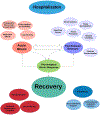Can hospitalization be hazardous to your health? A nosocomial based stress model for hospitalization
- PMID: 31376645
- PMCID: PMC6791742
- DOI: 10.1016/j.genhosppsych.2019.07.014
Can hospitalization be hazardous to your health? A nosocomial based stress model for hospitalization
Abstract
Objective: Hospitalization places patients at elevated risk for the development of "nosocomial" or hospital acquired complications, ranging from multidrug resistant infections to delirium and physical deconditioning. Adverse nosocomial psychological effects of hospitalization may also exist. This paper introduces a nosocomial based stress model, conceptualizing hospitalization as a unique period of biopsychosocial vulnerability, due to physiologic effects of acute illness and psychosocial variables of the hospital experience.
Method: A research synthesis and narrative review was performed to evaluate evidence supporting this model, integrating existing knowledge of the psychological and physiological effects of acute life threatening events, with known sequelae associated with hospitalization.
Result: Psychosocial factors during hospitalization may act as independent predictors of recovery following hospitalization, moderating variables impacting ongoing physiologic changes due to acute illness, and/or dynamic bidirectional elements, influencing medical and psychological outcomes in the near and long-term setting.
Conclusion: The Nosocomial Stress model provides a novel framework to understanding the biopsychosocial interactions between the psychological and physiologic processes associated with illness and hospitalization. Based on this model, a research agenda is proposed to assess the contributions of acute illness, the hospital experience, and their interactions on the recovery of patients following hospitalization.
Keywords: Hospital stressors; Hospitalization; Nosocomial stress.
Copyright © 2019 Elsevier Inc. All rights reserved.
Conflict of interest statement
Figures
References
-
- Carstens HR. The history of hospitals, with special reference to some of the world’s oldest institutions. Annals of Internal Medicine 1936;10:670–682.
-
- Mullan RJ and Frazier TM. “NOSOCOMIAL”: A BROADER PERSPECTIVE? American journal of epidemiology 1986;124:342–342. - PubMed
-
- Garner JS, Jarvis WR, Emori TG, Horan TC and Hughes JM. CDC definitions for nosocomial infections, 1988. American journal of infection control 1988;16:128–140. - PubMed
-
- Inouye SK, Schlesinger MJ and Lydon TJ. Delirium: a symptom of how hospital care is failing older persons and a window to improve quality of hospital care. The American journal of medicine 1999;106:565–573. - PubMed
Publication types
MeSH terms
Grants and funding
LinkOut - more resources
Full Text Sources
Medical


